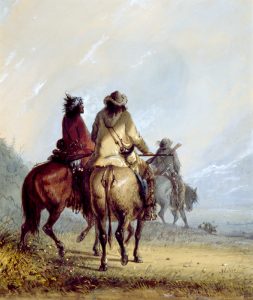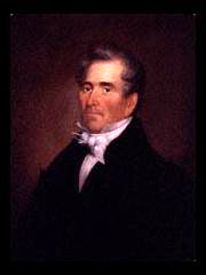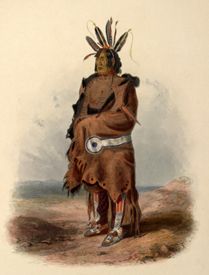Andrew Henry was a military officer, miner, frontiersman, trapper, and businessman.
Henry was born in 1775 in Fayette County, Pennsylvania, to George and Margaret Young Henry. Coming from a prominent family, he was educated as a young man. He left home at the age of 18 because his parents objected to the woman he wanted to marry. He never communicated with his family again.
How and where he spent the next few years is unknown, but by 1798, he was living in Nashville, Tennessee. In April 1800, he made his way to Ste. Genevieve, Missouri. There, he, along with William Ashley, purchased 640 acres of land in the lead mining district of Washington County. Located near present-day Potosi, Missouri, it became known as “Henry’s Diggings.”
In 1809, he joined Manuel Lisa, Jean Pierre Choteau, and William Clark to found the Missouri Fur Company. He led an expedition to the Three Forks of the Missouri River in Montana, where he built a trading post in 1810. However, the post did not last long, as constant attacks from Blackfeet Indians eventually caused it to be abandoned.
The following year he explored the Montana–Idaho wilderness, discovered Lake Henry, and built another trading post on the Snake River near present-day Saint Anthony, Idaho. During that time, they met the Mandan Indians. After more difficulties with Blackfeet warriors, Henry returned to St. Louis, Missouri, in January 1812.
He then joined in the War of 1812, rising to the rank of Major. Afterward, he returned to lead mining. In 1818, Henry married Mary Flemming, daughter of one of the lead mine owners. The couple would eventually have four children.
In 1822, Henry and William H. Ashley started the Rocky Mountain Fur Company. Running ads in St. Louis newspapers, the new company advertised they were looking to hire 100 men. Some of the men who responded included noted frontiersmen such as Jedediah Smith, William Sublette, Jim Beckwourth, Thomas Fitzpatrick, and David Edward Jackson, to name a few. Rather than relying on trading furs and pelts with the Indians, the Rocky Mountain Fur Company trained their men to do the trapping.
Later that year, Henry led a large expedition of 150 men up the Missouri River to the mouth of the Yellowstone River. There, they built a post that came to be known as Fort Henry in Montana. While exploring the area near Three Forks, he lost four men to Blackfeet warriors.
The Blackfeet were not the only Indians to fight back against the trading company. On June 2, 1823, the Arikara attacked a trapping expedition of the Rocky Mountain Fur Company along the Missouri River, resulting in about a dozen traders’ deaths. The attack occurred after a trading company employee killed a chief’s son, resulting in the Arikara War.
After being gone for over two years, Henry decided that the business did not make enough money to justify the effort expended in such a dangerous enterprise. He then sold his share of the partnership to Ashley and returned to Washington County, Missouri. Over the next two years, Ashley would bring back over $100,000 in beaver pelts.
Henry’s fur trading days were over, but he had left an indelible mark on the business. The rendezvous system he helped popularize would grow over the next decade to become a thriving commercial entity.
In the meantime, Henry returned to lead mining. He died in Washington County, Missouri, on January 10, 1832, at the age of 57.
Historian Hiram Chittenden described Henry as “tall and slender, yet of commanding presence, with dark hair and light eyes inclined to blue. He was fond of reading and playing the violin well.” He was also known to have a reputation for honesty, high ideals, and principles.
“Honor and self-respect are more to be prized than anything else.” — Andrew Henry
© Kathy Alexander/Legends of America, updated June 2023.
Also See:
Trading Posts of the Mountain Men
Trappers, Traders & Pathfinders
Sources:
Historica.fandom
Montana Historical Society
National Park Service



